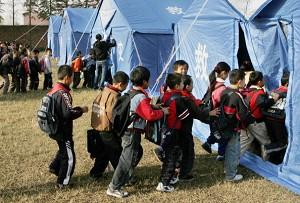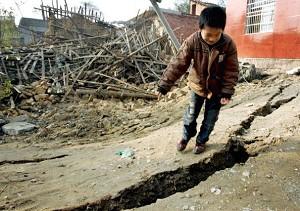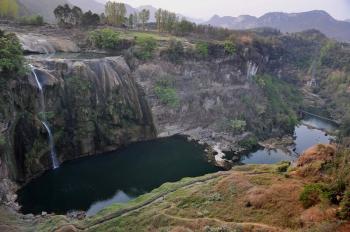After a magnitude 5.7 earthquake jolted Jiangxi Province, China, on November 26, the region was hit with 385 aftershocks over the next two days. The aftershocks fractured the Yangtze River levee at Jiujiang. A hole nearly 6,500 square feet in size appeared near the Changhe levee on one of the biggest branches of the Yangtze River.
The same stretch of the levee was also damaged in 1998, and former Premier Zhu Rongji called the construction a “tofu crumb project,” noting that the construction company had used poor quality and inadequate materials in order to maximize their profits.
Analysts pointed out that because the natural floodway areas along the Yangtze River have been completely destroyed, the River is very dangerous. Earthquakes in the region could also threaten the Three Gorges Dam, which is slated to be the largest dam in the world.
A total of 385 aftershocks were recorded between 8:49 a.m. and 6:40 a.m. on November 28 after the main shock on November 26. Chinese officials say that the earthquake is the largest one to hit the Jiujiang area since 1911. Deputy Secretary of Jiangxi Provincial Government Zheng Keqiang said that the Yangtze River levee fractured in several locations at Yongan, Jiujiang. The fractures are about 30 meters (98 feet) from the foot of the levee.
Ironically, after Premier Zhu criticized the construction quality of the levee in 1998, the levee was repaired in 1999 at a cost of 1.9 billion yuan (US$230 million). The project passed inspection in November 2002, and was ranked as a “High-Quality Project” at that time.
After the earthquake and the aftershocks, new horizontal and vertical fractures were found on the levee at Jiujiang; some about three inches in width. The Jiujiang levee along the Yangtze River is 77 miles in length, and about 12 miles from the epicenter of the earthquake.
A 2004 National Audit Office report found that more than 50 percent of the levee projects along the Yangtze River were made from poor quality and inadequate construction materials. After the earthquake, the Ruichang Municipal Government Building was also fractured in a number of places. Meetings had to be held outdoors.
News commentator Mr. Heng He told The Epoch Times that the earthquake in Jiujiang could have significant implications for the Three Gorges Dam, which is constructed in an area less stable than Jiujiang. If an earthquake or any unforeseeable disaster caused the Three Gorges Dam to rupture, the consequences would be horrific.
China-based Morning Post reported that a hole nearly 6,500 square feet in size appeared in the ground less than a mile from Ruichang City. The hole is only about 110 yards from the Changhe levee on one of the biggest branches of the Yangtze River.

Local residents called it a “bottomless pit.” The hole has become deeper since the aftershocks. A villager said on November 28, “It grew at least 2 meters deeper since yesterday! It’s distressing that it is so close to the main levee.”
Many other fissures and holes also appeared in close proximity to the main cave-in. The smallest hole was about 10 feet in diameter and filled with underground water. It was about approximately 6 feet deep.
The Jiangxi provincial government estimated that the earthquake caused 12 casualties, damaged tens of thousands of houses, forced more than 600,000 people to evacuate the area, and affected 5.6 million people across the province. Schools, hospitals, streets, bridges, the water supply, sewers, and other infrastructure also suffered damage.




Friends Read Free